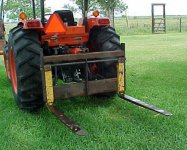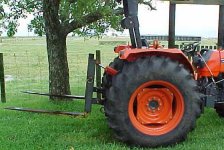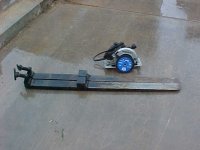Mark,
The forks were originally just one fork. The original was 6" wide, 52" from tip to inside bend at the elbow, and just over 1 3/4" thick. With the forks next to each other you get a good sense that they were once one fork, but I don't know if the picture conveys that very well.
To split the fork I used my trusty circular saw with a metal cutting abrasive blade . The blades come in 7-7 1/4" sizes which fit a circular saw perfectly (blade leaning against saw). Just clamp an upright 1x4 along one edge of the fork to use as a fence. Use a piece of wood as a spacer between the saw and fence to center the saw blade and away you go. Tiip: Check the blade for squareness to the base of the saw frequently to assure a perpendicular cut. Another Tip: Very shallow cuts work best.
Advantages:
1. Narrow kerf...not much fork width lost in the cutting process.
2. The cut is very straight, the edges are smooth.
3. NO grinding required.
Disadvantages:
1. Time consuming.
The process is NOT hard to do, just time intensive. As I recall, it took 8-10 hours to split the fork and the saw went through a half dozen blades or so. I did all my cutting on one weekend. A friend built a similar set and cut an hour at a time over a couple weeks.
If you decide to tackle the job, you won't be disappointed with the results.
OkieG







